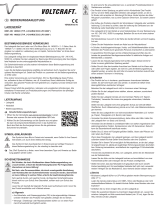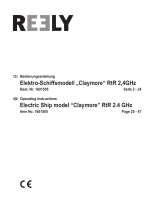6
• To prevent scratch marks and discolouration, always use suitable protection when placing the charger
on valuable furniture. The same applies to the rechargeable batteries.
• Do not use the charger inside vehicles.
• The charger must be installed, used and stored in areas that are inaccessible to children. Children may
accidentally short-circuit the rechargeable batteries, which can cause a re or explosion. Fatal hazard!
• Do not use the charger in the immediate vicinity of strong magnetic/electromagnetic elds, transmitter
aerials or HF generators. These may affect the electronic control system.
• Do not allow the power cable or battery cables to be squashed or damaged by sharp edges. Do not place
any objects on the cables.
• Do not place any objects that contain liquid (e.g. vases or plants) on or next to the charger or power
cable.
Liquids may destroy the charger and cause a re. If liquids do get inside the charger, disconnect the
charger from the power supply, and then remove all connected batteries. Discontinue use and take the
charger to a specialist repair centre.
c) Operation
• The charger can powered by a stabilized direct voltage (11 - 32 V/DC), e.g. with a suitable power adapt-
er, a car lead-acid battery, or a suitably powerful LiPo recharge battery.
• When handling the charger or rechargeable batteries, never wear metal or conductive objects (e.g. jew-
ellery such as necklaces, bracelets or rings). This may cause a short circuit in the rechargeable battery
or charging cable, which can lead to a re or explosion.
• Never leave the product unattended during use. The charger comes with a range of safety mechanisms
to ensure safe use. However, malfunctions may still occur from time to time.
• Ensure there is sufcient ventilation during use; never cover the charger. To prevent the charger from
overheating and causing a re, leave sufcient distance (min. 20 cm) between the charger and other
objects.
• The charger is only suitable for charging LiPo rechargeable batteries with 3 or 4 cells. Never charge oth-
er types of rechargeable batteries or non-rechargeable batteries, as this may cause a re or explosion!
• Batteries are connected to the charger via the balancer terminal. Make sure that the other cables con-
nected to the battery cannot trigger a short circuit, as this may cause a re or explosion!
• Do not connect several chargers together.
• The charger has four independent charging channels that can charge up to four batteries/battery packs
at the same time. However, only one battery/battery pack can be connected to each charging channel.
Never attempt to connect the charging channels together!
• Only use the product in temperate climates. It is not suitable for use in tropical climates. Refer to the
“Technical data” section for information on the permitted ambient conditions.
• Never use the product immediately after it has been brought from a cold room into a warm one. This may
generate condensation, which can cause the charger to malfunction or damage the interior components.
Allow the product to reach room temperature before using it. This may take several hours.






















